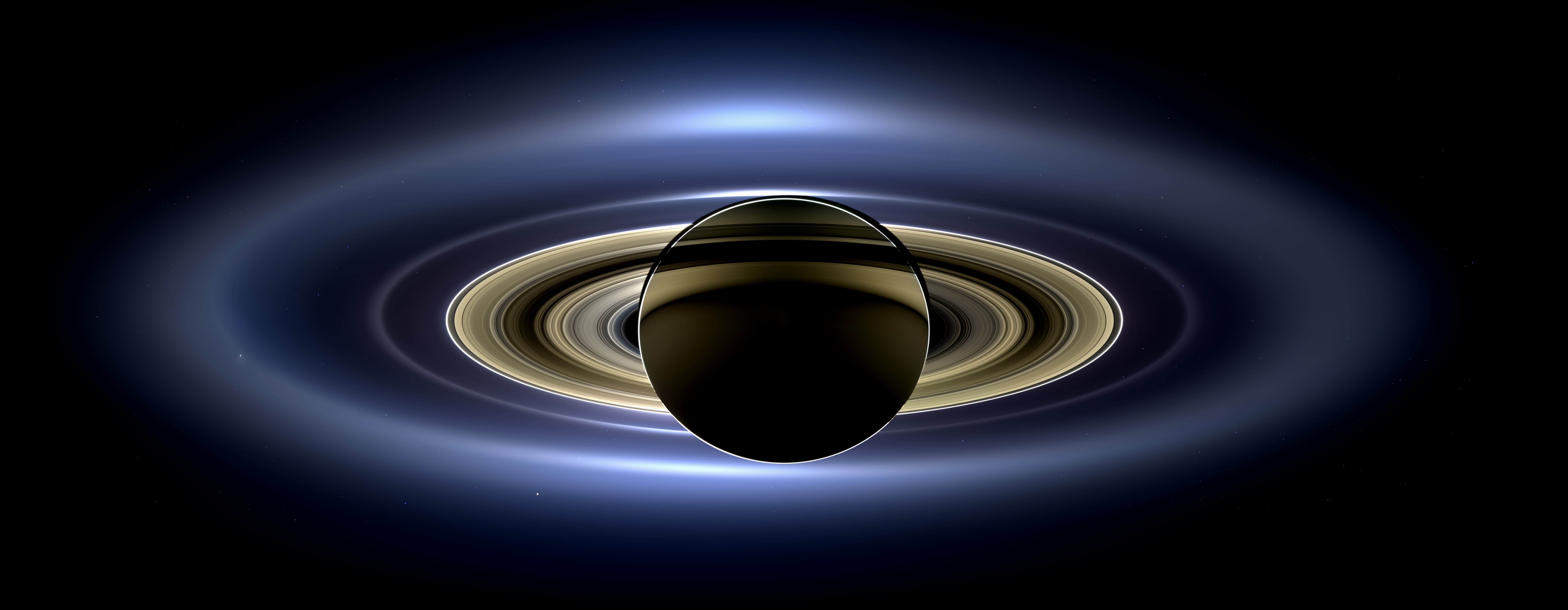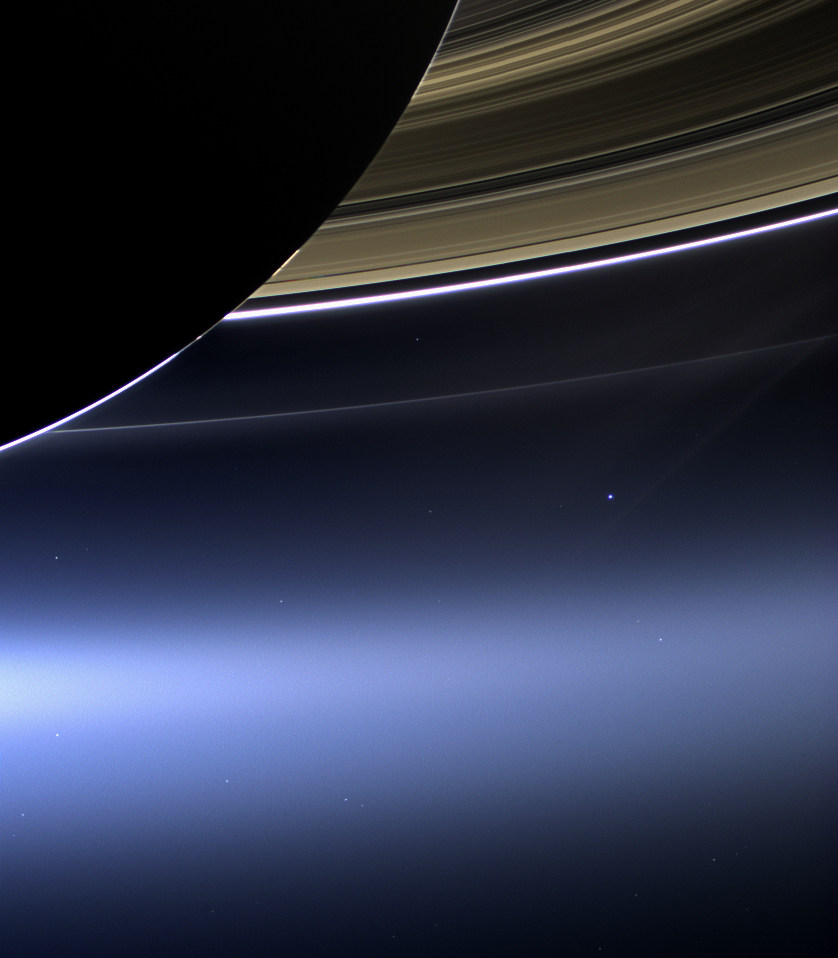The Day The Earth Smiled on:
[Wikipedia]
[Google]
[Amazon]


 ''The Day the Earth Smiled'' is a composite photograph taken by the NASA spacecraft '' Cassini'' on July 19, 2013. During an
''The Day the Earth Smiled'' is a composite photograph taken by the NASA spacecraft '' Cassini'' on July 19, 2013. During an
''The Day the Earth Smiled'' official website
Raw Images
{{DEFAULTSORT:Day The Earth Smiled, The Astronomy events 2013 in space Saturn Photographs of Earth from outer space 2013 works 2010s photographs Cassini–Huygens Astronomy image articles July 2013 events


 ''The Day the Earth Smiled'' is a composite photograph taken by the NASA spacecraft '' Cassini'' on July 19, 2013. During an
''The Day the Earth Smiled'' is a composite photograph taken by the NASA spacecraft '' Cassini'' on July 19, 2013. During an eclipse
An eclipse is an astronomical event that occurs when an astronomical object or spacecraft is temporarily obscured, by passing into the shadow of another body or by having another body pass between it and the viewer. This alignment of three ce ...
of the Sun, the spacecraft turned to image Saturn
Saturn is the sixth planet from the Sun and the second-largest in the Solar System, after Jupiter. It is a gas giant with an average radius of about nine and a half times that of Earth. It has only one-eighth the average density of Earth; h ...
and most of its visible ring system, as well as Earth and the Moon as distant pale dots. The spacecraft had twice taken similar photographs (in 2006 and 2012) in its previous nine years in orbit around the planet. The name also refers to the activities associated with the event, as well as to the photographic mosaic
In the field of photographic imaging, a photographic mosaic, also known under the term Photomosaic, is a picture (usually a photograph) that has been divided into (usually equal sized) tiled sections, each of which is replaced with another phot ...
created from it.
Conceived by the planetary scientist
Planetary science (or more rarely, planetology) is the scientific study of planets (including Earth), celestial bodies (such as moons, asteroids, comets) and planetary systems (in particular those of the Solar System) and the processes of their ...
Carolyn Porco
Carolyn C. Porco (born March 6, 1953) is an American planetary scientist who explores the outer Solar System, beginning with her imaging work on the Voyager missions to Jupiter, Saturn, Uranus and Neptune in the 1980s. She led the imaging scienc ...
, the imaging team leader for ''Cassini'', the concept called for the people of the world to reflect on their place in the universe, to marvel at life on Earth, and, at the time the pictures were taken, to look up and smile in celebration.
The final mosaic captured on July 19, processed at the Cassini Imaging Central Laboratory for Operations (CICLOPS), was released to the public on November 12, 2013. The photograph includes Earth, Mars, Venus, and many Saturnian moons. A higher-resolution image, depicting Earth and the Moon as distinct points of light, was taken with ''Cassini'' narrow-angle camera and was released shortly afterwards.
Events
The '' Cassini'' probe took images of Earth and the Moon from close to a billion miles away at 21:27 UTC, July 19, 2013. A number of activities were planned to celebrate the occasion: * A website was set up as a portal to activities associated with July 19. On it, Porco encouraged the world to celebrate life on planet Earth and humanity's accomplishments in the exploration of the Solar System. *Astronomers Without Borders
Astronomers Without Borders (AWB) is a U.S.-based organization founded by Mike Simmons, dedicated to spreading astronomy throughout the world and connecting people through this universal interest. Projects include crowdfunding in developed countri ...
coordinated events internationally.
* NASA spearheaded a related event called 'Wave at Saturn' "to help acknowledge the historic interplanetary portrait as it is being taken".
* A "Message to the Milky Way" contest was held by Porco's company, Diamond Sky Productions. People could submit a digital photo taken on July 19 and/or a musical composition. The winning entries were beamed as a message to extraterrestrials, "into the Milky Way from the Arecibo Radio Telescope in Puerto Rico". This follows the example set in 1974, when the first serious effort at communication to alien civilizations, the Arecibo message
The Arecibo message is an interstellar radio message carrying basic information about humanity and Earth that was sent to the globular cluster Messier 13 in 1974. It was meant as a demonstration of human technological achievement, rather than a ...
, was broadcast from Arecibo.
Results
Raw images from ''Cassini'' were received on Earth shortly after the event, and a couple of processed images—a high-resolution image of the Earth and the Moon, and a small portion of the final wide-angle mosaic showing the Earth—were released to the public a few days following the July 19 imaging sequence. Processing of the full mosaic took place at CICLOPS under Porco's direction over the course of approximately two months. During the four hours it took ''Cassini'' to image the entire -wide scene, the spacecraft captured a total of 323 images, 141 of which were used in the mosaic. NASA revealed that this imaging marked the first time four planets – Saturn, Earth, Mars, and Venus – had been captured at once in visible light by the ''Cassini'' craft. It was also the first time the people of Earth knew in advance that their picture would be taken from the outer Solar System. NASA's official release of the final ''The Day the Earth Smiled'' mosaic on November 12, 2013, was met with much fanfare in news media outlets around the world. The image graced the front page of ''The New York Times'' the following day. Public figures including media producerSeth MacFarlane
Seth Woodbury MacFarlane (; born October 26, 1973) is an American actor, animator, filmmaker, comedian, and singer. He is the creator and star of the television series ''Family Guy'' (since 1999) and ''The Orville'' (since 2017), and co-creator ...
lauded the image. The mosaic was also presented by Carolyn Porco, and dedicated to the late astronomer Carl Sagan
Carl Edward Sagan (; ; November 9, 1934December 20, 1996) was an American astronomer, planetary scientist, cosmologist, astrophysicist, astrobiologist, author, and science communicator. His best known scientific contribution is research on ext ...
, at a ceremony at the Library of Congress in honor of its acquisition of Sagan's papers. In addition, a collage of images submitted by 1,600 members of the public to NASA's Wave at Saturn campaign was released on November 12.
See also
* ''The Blue Marble
''The Blue Marble'' is an image of Earth taken on December 7, 1972, from a distance of around from the planet's surface. Taken by the crew of the Apollo 17 spacecraft on its way to the Moon, it is one of the most reproduced images in history. ...
''
* Earth Anthem
* Earth Day
Earth Day is an annual event on April 22 to demonstrate support for environmental protection. First held on April 22, 1970, it now includes a wide range of events coordinated globally by EarthDay.org (formerly Earth Day Network) including 1 b ...
* ''Earthrise
''Earthrise'' is a photograph of Earth and some of the Moon's surface that was taken from lunar orbit by astronaut William Anders on December 24, 1968, during the Apollo 8 mission. Nature photographer Galen Rowell described it as "the most infl ...
''
* ''Pale Blue Dot
''Pale Blue Dot'' is a photograph of planet Earth taken on February 14, 1990, by the ''Voyager 1'' space probe from a record distance of about kilometers ( miles, 40.5 AU), as part of that day's ''Family Portrait'' series of images of the ...
''
* ''Solar System Family Portrait''
* Space selfie
A space selfie is a selfie (self-portrait photograph typically posted on social media sites) that is taken in outer space. This include selfies taken by astronauts (also known as astronaut selfies), machines (also known as space robot selfies and ...
References
External links
''The Day the Earth Smiled'' official website
Raw Images
{{DEFAULTSORT:Day The Earth Smiled, The Astronomy events 2013 in space Saturn Photographs of Earth from outer space 2013 works 2010s photographs Cassini–Huygens Astronomy image articles July 2013 events